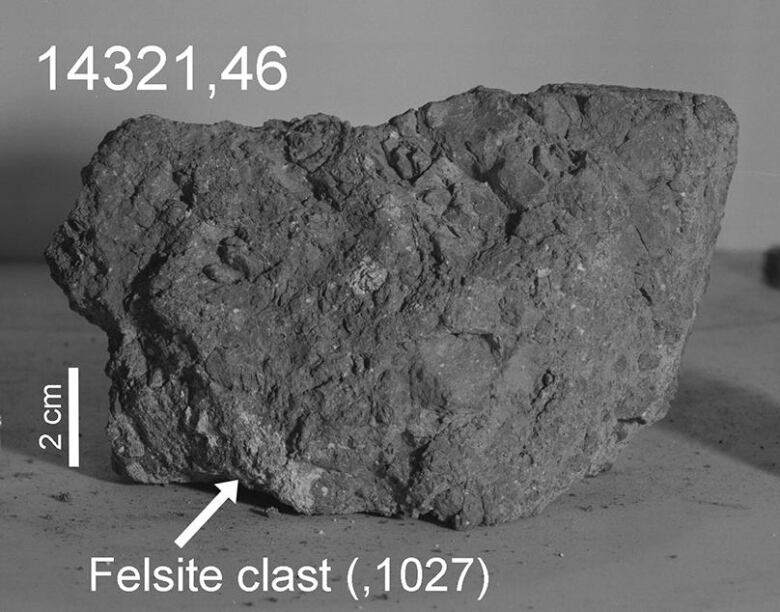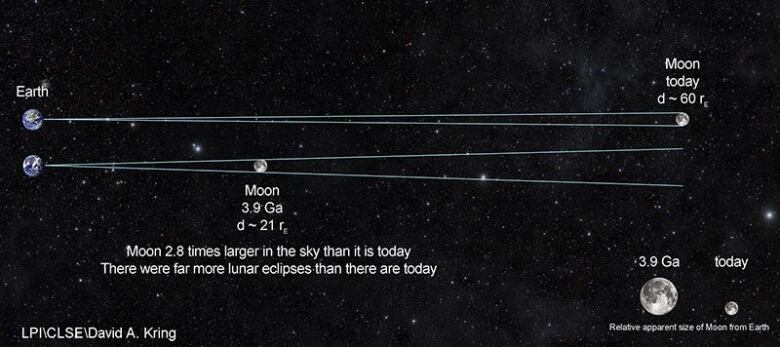Scientists believe they've found the oldest known Earth rock on the moon
Fragment was likely ejected from Earth almost 4 billion years ago

Almost 48 years after it was collected, scientists believe a rock sample taken during an Apollo mission to the moon originated from Earth roughly four billion years ago.
From Apollo 11 the first mission to land on the moon to the final Apollo 17 mission, astronauts visiting the moon were tasked with many scientific objectives, including collecting rocks to bring back for analysis.
The team of scientistspublished their findings in the journal Earth and Planetary Science Lettersand used new technology to study a two-gram sample of moon rock collected by the Apollo 14 astronauts in 1971. Their findings suggest that, instead of the rock originating on the moon, it came from Earth four billion years ago.

The researchers believe the rock sampleis a type of felsite, which is composed of feldspar, quartz and a tiny bit of zircon. It's similar to granite, which is the type of rock that forms continents. Scientists believeit is produced through plate tectonics, the way Earth's outer crust moves. It is highly unusual to find it on the moon.
The findings suggest that the best explanation for the existence of that type of rock on the moon is that it's not from the moon at all.It's fromEarth.
Surviving many blasts
Chemical analysis of the fragment revealed it had crystallized. The scientists suggest conditions on Earth justabout 20 kilometres below the surface about four to 4.1 billion years ago, could have caused this process.
"It was confirmation that we had something granitic and that we had large enough impact events to launch things from the Earth," says co-author David A. Kring, principal investigator at the Center for Lunar Science and Exploration at the Lunar and Planetary Institute. "It's amazing that the rock survived."
It's amazing because this particular sample underwent three significant impacts. The solar system was rife with large bodies that were zipping around the sun as planets and moons were forming. Around this time referred to the Late Heavy Bombardment Period it's believed Earth was being blasted with debris.
Shortly after our planet's formation, several large bodies, such as an asteroid or comet, slammed into Earth, eventually displacing the rock and sending it into space. It reached the lunar surface. The moon would have been 2.8 times closer to Earth than it is today.
Once there, the theory goes, it survived subsequent impact events including oneroughly 3.9 billion years ago, when a large impact partially melted the rock,and it likely was buried beneath the moon's surface in the Imbrium Basin.

But it wouldn'tstaythere.
There was another large impact in the regionthat sent the fragment roughly 200 kilometresfrom itslanding location.
And finally, the researchers theorize that about 26 million years ago, an asteroid impacted the moon, creating the 340-metrediameter Cone Crater, bringing it back up to the surface where the astronauts found it.
A less likely explanation
There could be another explanation, albeit less likely, the scientists say.
The rock could have crystallized on the moon. However, it would have to have been 130 kilometresbelow the surface, which would place it in the moon's mantle, something that would require an entirely different understanding of the moon than we currently have.
Gordon (Oz)Osinski, director of the Canadian Lunar Research Networkand professor at WesternUniversity'sdepartments of earth sciences and physics and astronomy, believes the researchers' explanation is the most plausible.
"It's totally feasible, and there've been a few papers over the last several decades that this is possible, and this particular one, they definitely present some convincing evidence," he says.
"Hopefully this will spur interest in people looking at other similar [samples] in the Apollo collection."
Most of the rocks on Earth are younger than four billion years old, and both scientists say that, in order to determine how our planet formed, finding these older rocks is key.
With NASA's recent attention on returning humans to the moon, Kring hopes more samples will be collected. And that, he says, will help us learn about our early solar system, and thus, ourselves.
"The larger number of samples that we find, the better picture we'll paint of the early Earth," says Kring. "And I think all of us are interested in the origin and early evolution of our planet. And there's no doubt the best record of those processes are on the moon."












_(720p).jpg)


 OFFICIAL HD MUSIC VIDEO.jpg)
.jpg)



























































































